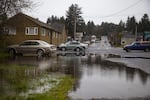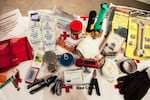
A parking lot floods during a king tide in Nehalem, Oregon.
Erin Ross / OPB
Floods are among the most common natural disasters across the U.S. Meteorologists and emergency management officials warn they can happen almost anywhere.
According to the National Weather Service, flooding happens nearly every day somewhere in the country. Floods, which vary in speed, time and impact, can be costly and deadly.
“Flooding can cause more damage in the United States than any other weather-related event — with an average of 8 billion dollars a year,” said the National Weather Service on its website. “Flooding is also one of America’s most underrated killers, causing nearly 90 fatalities per year.”
In Oregon, there are more than 250 communities in Oregon living in flood-prone areas, including 212 cities and three tribal nations. That’s according to data collected by the National Flood Insurance Program.
Here are some tips on how to prepare and stay safe during a flood:
Be prepared
- Know your flood risk. Tools like FEMA’s Flood Map Service Center allows users to search online to see if their homes could be impacted by flooding.
- Make an evacuation plan and practice it. Floods can be sudden and destructive. Emergency management officials recommend making a plan outlining where to go and what to bring. If possible, learning and practicing evacuation routes is also recommended.
- Inform local authorities ahead of time about any special needs within your household. This includes needing additional assistance for elderly or disabled people.
- Keep important documents in a waterproof container.
- Identify and clear out potential hazards around your home. This includes decluttering drains and gutters as well as turning off your electrical power and gas before evacuating.
- Purchase flood insurance and make an inventory of all of your personal property.
- Buy and install sump pumps with back-up power.

The American Red Cross recommends that each household have a hand-crank radio or other battery-powered communication device to tune in to emergency broadcasts and disaster relief messages.
Alan Sylvestre / OPB
Stay informed
- Listen to NOAA Weather Radio or your local radio and TV broadcasters for emergency alerts.
- Be on the lookout for possible Wireless Emergency Alerts sent to your cell phone. These alerts are short emergency messages based on your location.
- Check out the National Weather Service’s website for active flooding warnings and advisories.
- Follow your local emergency management office or news outlets on social media for updates.

Emergency kits can contain everyday household items, like blankets, non-perishable food and communication devices like radios.
Alan Sylvestre / OPB
Making an emergency kit
An emergency kit contains supplies that could be needed should a natural disaster strike. Many emergency management officials recommend having enough supplies to last at least two weeks.
- At least 1 gallon of water per day for two weeks for several days.
- Non-perishable, easy-to-prepare food.
- A first aid kit.
- Flashlight and extra batteries.
- Battery-powered or hand-crank radio.
- Sanitation and personal hygiene items.
- Blankets, extra clothing and shoes.
- Medication and medical information.
- Copies of important, personal documents.
- Cell phone charger.
- Family and emergency contact information.
- Extra cash.
- Maps of the area.